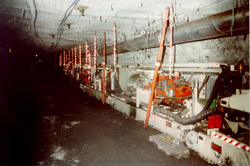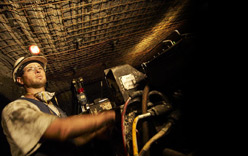Equipment
Face Services
Face services include high and low voltage electric
power, water, compressed air, hydraulic fluids and possibly pumping. These are
required for:
-
High voltage power,
increased over time from 415v to the present preference for 3.3kv; required via
trailing cables to power the shearer and via fixed cables for the main and tailgate
drives
-
Most faces now have
lights attached to the chocks on a 240v supply via interchock cables
-
Low voltage power is
required for monitoring (typically operating parameters and location of the
shearer, chock operating parameters and gas concentrations at certain
locations) and for control of chock operations.
-
Water is required for
cooling of motors (main and tailgate drives and shearer), for dust control (on
the shearer drums and the crusher) and for fire fighting precautions. It may
also be needed for secondary roof bolting or drilling for various purposes on
the face, particularly during face recovery operations.
-
Compressed air is
seldom used on the main face equipment but is frequently required for pumping,
roof bolting or drilling as above and possibly for ventilation purposes such as
operation of venturi's. It may also be useful for machine maintenance and
repair purposes.
-
Hydraulic fluid,
usually a soluble oil/water emulsion, is required throughout the face from the
boot end to the last support at the tailgate. It is normally supplied in a
closed circuit with a return line running the length of the face back to the
pumps in the maingate.
-
The pumping referred to
here is of waste water which may collect at low points on the face or in the
gate roads and needs to be removed, possibly from one end of the face to the
other.
It is normal for water and compressed air to be
supplied from the mine reticulation systems, which would be in steel pipes in
the gate roads up to a point close to the face and would then be carried onto
and across the face in hoses with outlets at suitable intervals. The water
supply to the shearer would usually be run onto the face separate to the supply
for other purposes and may require a high pressure line for dust suppression
purposes.
Electric power and hydraulic fluid is supplied from
equipment usually in the maingate or adjacent roadway, consisting of
transformers, switchgear and electrical distribution boxes, hydraulic pumps and
tanks. There is also usually an enclosure containing face monitoring and
communication equipment.
On early mechanized longwalls, all this equipment was
mounted on skid or rail mounted bases in a long line alongside the maingate
conveyor. The bases were all connected together and were dragged forward as the
face advanced, in some cases with a winch and in others with a large hydraulic
cylinder mounted on a base with a large staker prop to the roof, also
hydraulically operated. The latter usually used a chain to pull the equipment
forward.
All this train of equipment is known as a "Pantechnicon",
a name generally shortened to "Pantec".
Later developments have included mounting the pumps
remotely, sometimes in the main headings in specially constructed pump
stations, with the fluid being carried in steel pipes for most of the distance
to the face. This has the advantage of the pumps being set in good, clean
conditions and not having to be moved frequently, sometimes being used for more
than one longwall block. The disadvantage is having to have pipes in the maingate
carrying high pressure fluids with associated safety issues and pressure losses
in the pipes.
 More recent longwalls have a set-up between the two
set-ups described above, where the pumps are located in a roadway adjacent to
the face some distance outbye the face position (of the order of 500m) and
relocated when the face is somewhat closer (usually before their location
becomes part of the "hazardous zone" where additional protection such as
flame-proofing is required). In this way the pumps, etc can be located in
relatively good conditions away from the immediate face area, are moved less
frequently than if they were in the face area, but have a smaller reticulation
system than the outbye stations. The transformers supplying power can also be
located a similar distance from the face.
More recent longwalls have a set-up between the two
set-ups described above, where the pumps are located in a roadway adjacent to
the face some distance outbye the face position (of the order of 500m) and
relocated when the face is somewhat closer (usually before their location
becomes part of the "hazardous zone" where additional protection such as
flame-proofing is required). In this way the pumps, etc can be located in
relatively good conditions away from the immediate face area, are moved less
frequently than if they were in the face area, but have a smaller reticulation
system than the outbye stations. The transformers supplying power can also be
located a similar distance from the face.
A large number of cables and hoses have to be run
between the Pantec or remote pump stations and transformers and this requires
some type of cable handling arrangement. To protect them in the area closer to
the face, they are normally run in a covered steel trough run alongside the BSL,
known as a "Rigid Bretby".
The enclosed trough runs around the back of the maingate drive onto the face
itself.
With a Pantec there is only a very short distance from
the Rigid Bretby to the end of the Pantec and the cable/hose lengths required
are fixed.
With a remote pump station/transformer set-up the
cable/hose lengths are very variable Rather than try to manhandle and
add/remove lengths, a monorail system is typically used. Loops of cables and
hoses are attached to monorail trolleys such that the loops can hang almost
roof to floor or can be stretched out almost horizontally, the difference in
overall length being the distance required for the pump/transformer relocation.
The monorail consists of short sections of rail which are hung from roof bolts.
As the face approaches, rail sections are removed and re-hung outbye ready for
the next relocation of the pumps/transformer.
Other items (eg tool boxes, fire fighting equipment)
can also be hung from the monorail if desired.
On the face itself, some cables and hoses require
connection to every chock. These are made in short lengths, known as interchock
hoses or cables, and often hung together in a cover to make handling easier.
Sockets/connectors are mounted on the chocks for attachment of these services
with through connections installed to connect to the next chock in line.
Cables and hoses which require no or infrequent
outlets/connections are usually run along brackets on the AFC back plates.
Austdac
Equipment
Macquarie
Manufacturing Pty. Ltd.

